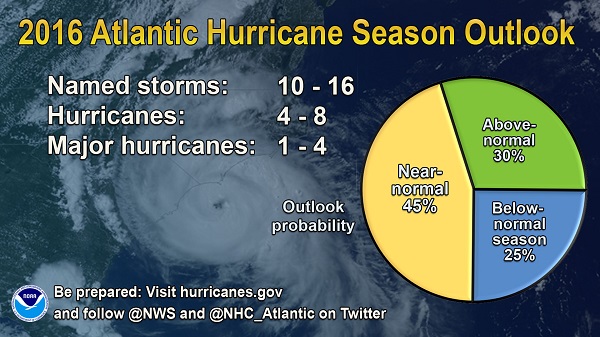Forecasters at NOAA’s Climate Prediction Center say the 2016 Atlantic hurricane season, which runs from June 1 through Nov. 30, will most likely be near-normal, but they also say this season is particularly difficult to pin down because there is so much uncertainty in the climate signals that influence the formation of Atlantic storms.
NOAA (National Oceanic & Atmospheric Administration) predicts a 70 percent likelihood of 10 to 16 named storms (winds of 39 mph or higher), of which 4 to 8 could become hurricanes (winds of 74 mph or higher), including 1 to 4 major hurricanes (Category 3, 4 or 5; winds of 111 mph or higher).
While a near-normal season is most likely with a 45 percent chance, according to NOAA, there is also a 30 percent chance of an above-normal season and a 25 percent chance of a below-normal season.
Included in the outlook published on May 27 is Hurricane Alex, a pre-season storm that formed over the far eastern Atlantic in January.
“This is a more challenging hurricane season outlook than most because it’s difficult to determine whether there will be reinforcing or competing climate influences on tropical storm development,” said Gerry Bell, Ph.D., lead seasonal hurricane forecaster with NOAA’s Climate Prediction Center. “However, a near-normal prediction for this season suggests we could see more hurricane activity than we’ve seen in the last three years, which were below normal.”
Bell said there is uncertainty about whether the high activity era of Atlantic hurricanes, which began in 1995, has ended. High- and low-activity eras typically last 25 to 40 years.

In addition, El Niño is dissipating and NOAA’s Climate Prediction Center is forecasting a 70 percent chance that La Niña—which favors more hurricane activity—will be present during the peak months of hurricane season, August through October. However, current model predictions show uncertainty as to how strong La Niña and its impacts will be.
NOAA says it has made investments and has new tools to deliver more accurate information during the hurricane season. These include an upgrade to its supercomputer and new capabilities in its forecasting models.
NOAA’s new National Water Model—set to launch later this summer—will provide hourly water forecasts for 700 times more locations than its current flood forecast system. In the fall, NOAA will launch GOES-R, a next generation weather satellite that will produce much sharper images of hurricanes and other severe weather.
NOAA said it will issue an updated outlook for the Atlantic hurricane season in early August, just prior to the peak of the season.
NOAA also issued its outlook for the eastern Pacific and central Pacific basins. The central Pacific hurricane outlook calls for equal 40 percent chance of a near-normal or above-normal season with 4-7 tropical cyclones likely. The eastern Pacific hurricane outlook calls for a 40 percent chance of a near-normal hurricane season, a 30 percent chance of an above-normal season and a 30 percent chance of a below-normal season. That outlook calls for a 70 percent probability of 13-20 named storms, of which 6-11 are expected to become hurricanes, including 3-6 major hurricanes.




















 Good Times for U.S. P/C Insurers May Not Last; Auto Challenges Ahead
Good Times for U.S. P/C Insurers May Not Last; Auto Challenges Ahead  Breaking: Andersen to Replace Zaffino as CEO of AIG on June 1
Breaking: Andersen to Replace Zaffino as CEO of AIG on June 1  How Insurers Can Avoid Post-Merger Technology Failure
How Insurers Can Avoid Post-Merger Technology Failure  Artificial Intelligence Is Rewriting the Rules for Commercial Lines
Artificial Intelligence Is Rewriting the Rules for Commercial Lines 




